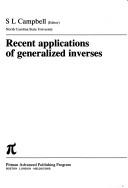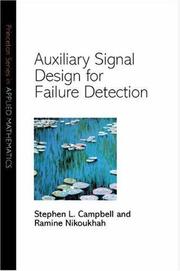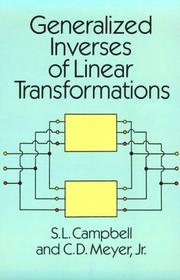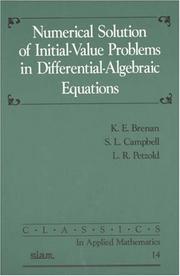| Listing 1 - 10 of 14 | << page >> |
Sort by
|

ISBN: 0273085506 9780273085508 Year: 1982 Volume: 66 Publisher: Boston: Pitman advanced publishing program,
Abstract | Keywords | Export | Availability | Bookmark
 Loading...
Loading...Choose an application
- Reference Manager
- EndNote
- RefWorks (Direct export to RefWorks)
Matrix inversion --- 512.64 --- Inverse matrices --- Inverse of a matrix --- Inversion, Matrix --- Linear operators --- Matrices --- Linear and multilinear algebra. Matrix theory --- Generalized inverses --- Matrix inversion. --- 512.64 Linear and multilinear algebra. Matrix theory
Book
ISBN: 3030048853 3030048845 Year: 2018 Publisher: Cham : Springer International Publishing : Imprint: Springer,
Abstract | Keywords | Export | Availability | Bookmark
 Loading...
Loading...Choose an application
- Reference Manager
- EndNote
- RefWorks (Direct export to RefWorks)
This book provides a tutorial in the use of Compose and Activate, software packages that provide system modeling and simulation facilities. Advanced system modeling software provide multiple ways of creating models: models can be programmed in specialized languages, graphically constructed as block-diagrams and state machines, or expressed mathematically in equation-based languages. Compose and Activate are introduced in this text in two parts. The first part introduces the multi-language environment of Compose and its use for modeling, simulation and optimization. The second describes the graphical system modeling and optimization with Activate, an open-system environment providing signal-based modeling as well as physical system component-based modeling. Throughout both parts are applied examples from mechanical, biological, and electrical systems, as well as control and signal processing systems. This book will be an invaluable addition with many examples both for those just interested in OML and those doing industrial scale modeling, simulation, and design. All examples are worked using the free basic editions of Activate and Compose that are available.
Computer simulation. --- Computer modeling --- Computer models --- Modeling, Computer --- Models, Computer --- Simulation, Computer --- Electromechanical analogies --- Mathematical models --- Simulation methods --- Model-integrated computing --- Computer software. --- Computer science. --- Mathematical Software. --- Computational Science and Engineering. --- Mathematical Modeling and Industrial Mathematics. --- Math Applications in Computer Science. --- Informatics --- Science --- Software, Computer --- Computer systems --- Computer mathematics. --- Mathematical models. --- Computer science—Mathematics. --- Models, Mathematical --- Computer mathematics --- Electronic data processing --- Mathematics
Book
ISBN: 1680159283 1400880041 9781680159288 9781400880041 Year: 2015 Publisher: Princeton, NJ : Princeton University Press,
Abstract | Keywords | Export | Availability | Bookmark
 Loading...
Loading...Choose an application
- Reference Manager
- EndNote
- RefWorks (Direct export to RefWorks)
Many industries, such as transportation and manufacturing, use control systems to insure that parameters such as temperature or altitude behave in a desirable way over time. For example, pilots need assurance that the plane they are flying will maintain a particular heading. An integral part of control systems is a mechanism for failure detection to insure safety and reliability. This book offers an alternative failure detection approach that addresses two of the fundamental problems in the safe and efficient operation of modern control systems: failure detection--deciding when a failure has occurred--and model identification--deciding which kind of failure has occurred. Much of the work in both categories has been based on statistical methods and under the assumption that a given system was monitored passively. Campbell and Nikoukhah's book proposes an "active" multimodel approach. It calls for applying an auxiliary signal that will affect the output so that it can be used to easily determine if there has been a failure and what type of failure it is. This auxiliary signal must be kept small, and often brief in duration, in order not to interfere with system performance and to ensure timely detection of the failure. The approach is robust and uses tools from robust control theory. Unlike some approaches, it is applicable to complex systems. The authors present the theory in a rigorous and intuitive manner and provide practical algorithms for implementation of the procedures.
System failures (Engineering) --- Fault location (Engineering) --- Signal processing. --- Processing, Signal --- Information measurement --- Signal theory (Telecommunication) --- Location of system faults --- System fault location (Engineering) --- Dynamic testing --- Failure of engineering systems --- Reliability (Engineering) --- Systems engineering --- A priori estimate. --- AIXI. --- Abuse of notation. --- Accuracy and precision. --- Additive white Gaussian noise. --- Algorithm. --- Approximation. --- Asymptotic analysis. --- Bisection method. --- Boundary value problem. --- Calculation. --- Catastrophic failure. --- Combination. --- Computation. --- Condition number. --- Continuous function. --- Control theory. --- Control variable. --- Decision theory. --- Derivative. --- Detection. --- Deterministic system. --- Diagram (category theory). --- Differential equation. --- Discrete time and continuous time. --- Discretization. --- Dynamic programming. --- Engineering design process. --- Engineering. --- Equation. --- Error message. --- Estimation theory. --- Estimation. --- Finite difference. --- Gain scheduling. --- Inequality (mathematics). --- Initial condition. --- Integrator. --- Invertible matrix. --- Laplace transform. --- Least squares. --- Likelihood function. --- Likelihood-ratio test. --- Limit point. --- Linear programming. --- Linearization. --- Mathematical optimization. --- Mathematical problem. --- Maxima and minima. --- Measurement. --- Method of lines. --- Monotonic function. --- Noise power. --- Nonlinear control. --- Nonlinear programming. --- Norm (mathematics). --- Numerical analysis. --- Numerical control. --- Numerical integration. --- Observational error. --- Open problem. --- Optimal control. --- Optimization problem. --- Parameter. --- Partial differential equation. --- Piecewise. --- Pointwise. --- Prediction. --- Probability. --- Random variable. --- Realizability. --- Remedial action. --- Requirement. --- Rewriting. --- Riccati equation. --- Runge–Kutta methods. --- Sampled data systems. --- Sampling (signal processing). --- Scientific notation. --- Scilab. --- Shift operator. --- Signal (electrical engineering). --- Sine wave. --- Solver. --- Special case. --- Stochastic Modeling. --- Stochastic calculus. --- Stochastic interpretation. --- Stochastic process. --- Stochastic. --- Theorem. --- Time complexity. --- Time-invariant system. --- Trade-off. --- Transfer function. --- Transient response. --- Uncertainty. --- Utilization. --- Variable (mathematics). --- Variance.
Digital
ISBN: 9783030048853 Year: 2018 Publisher: Cham Springer International Publishing
Abstract | Keywords | Export | Availability | Bookmark
 Loading...
Loading...Choose an application
- Reference Manager
- EndNote
- RefWorks (Direct export to RefWorks)
This book provides a tutorial in the use of Compose and Activate, software packages that provide system modeling and simulation facilities. Advanced system modeling software provide multiple ways of creating models: models can be programmed in specialized languages, graphically constructed as block-diagrams and state machines, or expressed mathematically in equation-based languages. Compose and Activate are introduced in this text in two parts. The first part introduces the multi-language environment of Compose and its use for modeling, simulation and optimization. The second describes the graphical system modeling and optimization with Activate, an open-system environment providing signal-based modeling as well as physical system component-based modeling. Throughout both parts are applied examples from mechanical, biological, and electrical systems, as well as control and signal processing systems. This book will be an invaluable addition with many examples both for those just interested in OML and those doing industrial scale modeling, simulation, and design. All examples are worked using the free basic editions of Activate and Compose that are available.
Mathematical control systems --- Mathematics --- Planning (firm) --- Computer science --- Computer architecture. Operating systems --- Computer. Automation --- bedrijfssoftware --- computers --- informatica --- mathematische modellen --- wiskunde --- informaticaonderzoek --- computerkunde
Book
ISBN: 9781400880041 Year: 2015 Publisher: Princeton, NJ
Abstract | Keywords | Export | Availability | Bookmark
 Loading...
Loading...Choose an application
- Reference Manager
- EndNote
- RefWorks (Direct export to RefWorks)

ISBN: 9781400880041 9780691099873 Year: 2015 Publisher: Princeton, N.J. Princeton University Press
Abstract | Keywords | Export | Availability | Bookmark
 Loading...
Loading...Choose an application
- Reference Manager
- EndNote
- RefWorks (Direct export to RefWorks)

ISBN: 048666693X 9780486666938 Year: 1991 Publisher: New York (N.Y.): Dover,
Abstract | Keywords | Export | Availability | Bookmark
 Loading...
Loading...Choose an application
- Reference Manager
- EndNote
- RefWorks (Direct export to RefWorks)
Matrix inversion. --- Transformations (Mathematics). --- Transformations (Mathematics) --- MATRIX INVERSION
Book
ISBN: 0898716713 9780898716719 Year: 2009 Publisher: Philadelphia: Society for industrial and applied mathematics,
Abstract | Keywords | Export | Availability | Bookmark
 Loading...
Loading...Choose an application
- Reference Manager
- EndNote
- RefWorks (Direct export to RefWorks)

ISBN: 0898713536 9780898713534 Year: 1996 Volume: 14 Publisher: Philadelphia: Society for industrial and applied mathematics,
Abstract | Keywords | Export | Availability | Bookmark
 Loading...
Loading...Choose an application
- Reference Manager
- EndNote
- RefWorks (Direct export to RefWorks)
Initial value problems --- Numerical solutions --- Numerical analysis --- Numerical solutions. --- Basic Sciences. Mathematics --- Numerical Mathematics --- Numerical Mathematics. --- Differential equations --- Équations différentielles --- Problèmes aux valeurs initiales --- Équations différentielles. --- Problèmes aux valeurs initiales. --- Analyse numérique. --- Differential equations. --- Initial value problems. --- Problèmes aux valeurs initiales --- Analyse numérique --- Numerical analysis. --- Systèmes dynamiques --- Initial value problems - Numerical solutions --- Initial value problems. Numerical solutions --- Resolution numerique --- Equations differentielles
Book
ISBN: 1441955348 1441955267 1441955275 Year: 2010 Publisher: New York, NY : Springer New York : Imprint: Springer,
Abstract | Keywords | Export | Availability | Bookmark
 Loading...
Loading...Choose an application
- Reference Manager
- EndNote
- RefWorks (Direct export to RefWorks)
ScicosLab is a free open-source software package for scientific computation. It includes a Scilab interpreter and hundreds of general purpose and specialized functions for numerical computation, organized in libraries called toolboxes, which cover such areas as simulation, optimization, systems and control, and signal processing. One important ScicosLab toolbox is Scicos. Scicos provides a block diagram graphical editor for the construction and simulation of dynamical systems. The objective of this book is to provide a tutorial for the use of Scilab/Scicos with a special emphasis on modeling and simulation tools. The book is based on the new ScicosLab 4.4. While the book will provide useful information to experienced users it is designed to be accessible to beginning users from a variety of disciplines. Students and academic and industrial scientists and engineers should find it useful. The book is divided into two parts. The first part concerns Scilab and includes a tutorial covering the language features, the data structures and specialized functions for doing graphics, importing, exporting data and interfacing external routines. It also covers in detail the numerical solvers for ordinary differential equations and differential-algebraic equations available in ScicosLab. Even though the emphasis is placed on modeling and simulation applications, this part provides a global view of the Scilab language. The second part is dedicated to modeling and simulation of dynamical systems in Scicos. This type of modeling tool is widely used in industry because it provides a means for constructing modular and reusable models. This part contains a detailed description of the editor and its usage, which is illustrated through numerous examples. All codes used in the book are made available to the reader. This book is an updated and expanded version of an earlier edition based on Scilab 3.1. Stephen L. Campbell is a professor of mathematics and director of graduate programs at North Carolina State University, a fellow of the IEEE, and has published extensively on numerical methods and control. Jean-Philippe Chancelier is affiliated with CERMICS Ecole Nationale des Ponts et Chaussees and is one of the original developers of Scilab. Ramine Nikoukhah is a director of research at INRIA (The French National Institute for Research in Computer Science and Control), senior member of IEEE, one of the original developers of Scilab, and is the creator of Scicos. .
Electronic books. -- local. --- Science -- Data processing. --- Scilab (Computer file). --- Science --- Physical Sciences & Mathematics --- Mathematics --- Mathematics - General --- Sciences - General --- Data processing --- Data processing. --- Scilab (Computer file) --- Electronic data processing --- Mathematics. --- Operations research. --- Decision making. --- Computers. --- Mathematical analysis. --- Analysis (Mathematics). --- Dynamics. --- Ergodic theory. --- Computer mathematics. --- Control engineering. --- Robotics. --- Mechatronics. --- Analysis. --- Theory of Computation. --- Computational Mathematics and Numerical Analysis. --- Control, Robotics, Mechatronics. --- Dynamical Systems and Ergodic Theory. --- Operation Research/Decision Theory. --- Global analysis (Mathematics). --- Information theory. --- Computer science --- Differentiable dynamical systems. --- Operations Research/Decision Theory. --- Operational analysis --- Operational research --- Industrial engineering --- Management science --- Research --- System theory --- Differential dynamical systems --- Dynamical systems, Differentiable --- Dynamics, Differentiable --- Differential equations --- Global analysis (Mathematics) --- Topological dynamics --- Computer mathematics --- Discrete mathematics --- Communication theory --- Communication --- Cybernetics --- Analysis, Global (Mathematics) --- Differential topology --- Functions of complex variables --- Geometry, Algebraic --- Deciding --- Decision (Psychology) --- Decision analysis --- Decision processes --- Making decisions --- Management --- Management decisions --- Choice (Psychology) --- Problem solving --- Ergodic transformations --- Continuous groups --- Mathematical physics --- Measure theory --- Transformations (Mathematics) --- 517.1 Mathematical analysis --- Mathematical analysis --- Dynamical systems --- Kinetics --- Mechanics, Analytic --- Force and energy --- Mechanics --- Physics --- Statics --- Mechanical engineering --- Microelectronics --- Microelectromechanical systems --- Automation --- Machine theory --- Control engineering --- Control equipment --- Control theory --- Engineering instruments --- Programmable controllers --- Automatic computers --- Automatic data processors --- Computer hardware --- Computing machines (Computers) --- Electronic brains --- Electronic calculating-machines --- Electronic computers --- Hardware, Computer --- Computer systems --- Calculators --- Cyberspace --- Decision making --- Computer science. --- Automation. --- Dynamical systems. --- Control, Robotics, Automation. --- Dynamical Systems. --- Operations Research and Decision Theory. --- Informatics --- Automatic factories --- Automatic production --- Computer control --- Engineering cybernetics --- Factories --- Mechanization --- Assembly-line methods --- Automatic control --- Automatic machinery --- CAD/CAM systems --- Robotics --- Automatic control.
| Listing 1 - 10 of 14 | << page >> |
Sort by
|

 Search
Search Feedback
Feedback About UniCat
About UniCat  Help
Help News
News